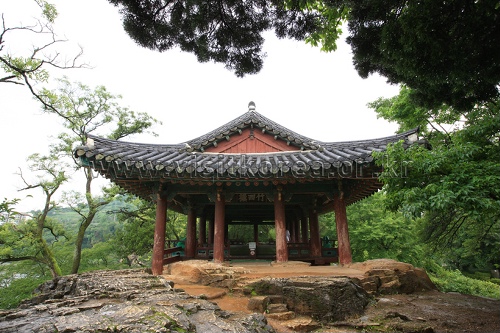Discover the Charming Jukseoru Pavilion
Welcome to Jukseoru Pavilion, a historic gem nestled in the heart of Gwandong District, South Korea. With its fascinating history, stunning architecture, and breathtaking natural surroundings, this is a must-visit destination for history buffs, nature enthusiasts, and culture seekers alike. Let’s embark on a journey to explore the captivating allure of Jukseoru Pavilion.
A Glimpse into History
Step back in time as you set foot in Jukseoru Pavilion, believed to have been built in 1266. This pavilion is one of the eight major attractions of Gwandong District, forming part of the renowned Gwandong Palgyeong, the “eight famous sites.” As you wander through its hallowed halls, you’ll find yourself immersed in centuries of history and culture.
The architecture of Jukseoru Pavilion is a sight to behold. Perched on the edge of a cliff, overlooking the picturesque Osipcheon Stream, the pavilion seamlessly merges with its natural surroundings. The rocks on the cliff act as cornerstones, while the elegant five-girder paljak roof adds a touch of ancient grandeur. Prepare to be captivated by the harmonious blend of human creativity and the beauty of nature.
Inscriptions and Legends
As you explore the pavilion, keep an eye out for the 26 signboards hanging from the rafters. These signboards bear inscriptions by renowned ancient scholars, each adding to the historical significance of Jukseoru Pavilion.
Among the notable scholars who have left their mark here are Heo Mok, Yi Seong-jo, and Yi Gyu-heon. Their inscriptions, such as “The best riverside pavilion” and “The best pavilion in Gwandong,” reflect the high esteem in which Jukseoru Pavilion was held throughout the centuries. Even kings like Sukjong and Jeongjo, as well as revered scholar Yulgok YiYi, have been inspired by this magnificent location.
These inscriptions serve as a testament to the enduring inspiration that Jukseoru Pavilion has provided over the years. As you stand in the presence of such storied history, you’ll feel a connection to the past and gain a deeper appreciation for the cultural significance of this iconic site.
Unforgettable Surroundings
While Jukseoru Pavilion’s historical and architectural significance is undeniable, its natural surroundings are equally enchanting. As you gaze out from the pavilion, you’ll be treated to panoramic views of the surrounding nature, including the tranquil Osipcheon Stream.
The serenity of the stream, combined with the lush greenery and the gentle sound of flowing water, creates an atmosphere of utter tranquility. It’s no wonder that Jukseoru Pavilion has been regarded as a place where both humans and marine gods find solace.
How to Get Here
If you’re traveling from Seoul, the easiest way to reach Jukseoru Pavilion is by taking a bus from Seoul Express Terminal to Samcheok Bus Terminal. From there, you’ll enjoy a leisurely 10-15 minute walk to the pavilion. The journey itself is an opportunity to soak in the beauty of the region as you make your way to this historic destination.
In conclusion, Jukseoru Pavilion offers a unique blend of history, culture, and natural beauty. From its ancient architecture to the inspiring inscriptions and the breathtaking surroundings, every aspect of this enchanting site is sure to leave a lasting impression. So, come and experience the magic of Jukseoru Pavilion for yourself – a place where the past and present converge in harmony.

